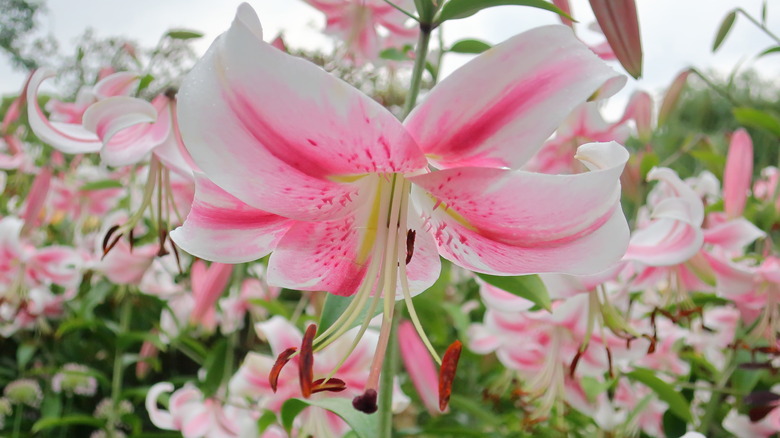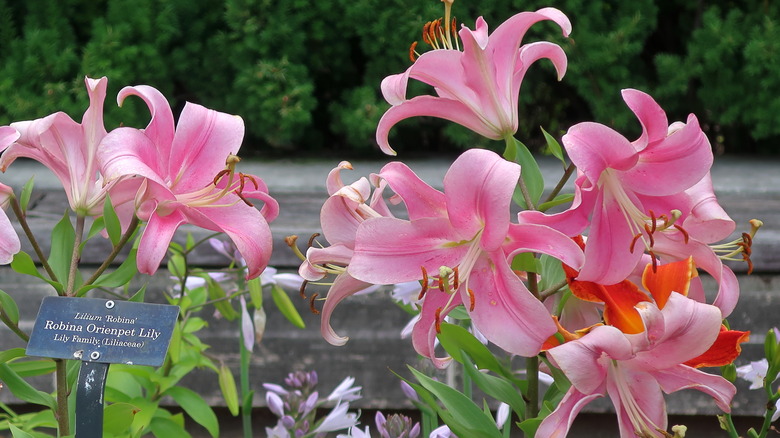How To Plant Lily Tree Bulbs
Towering above other plants in the Lilium genus, lily trees aren't actually trees. Also called tree lilies, this common name simply describes their supersized height, which may reach 8 feet when plants are grown in USDA plant hardiness zones 3 through 8.
Typically, it takes several years for a tree lily to attain its mature height, but the spectacular combination of size and showstopping flowers is worth the wait. Planting tree lily bulbs is a snap, and just a few tips can optimize the health and growth of your plants.
What Is a Tree Lily?
While "tree lily" and "lily tree" are common names that describe the size of this plant, "Orienpet" is another common name that describes its parentage. As a hybrid cross of Oriental lilies and trumpet lilies, Orienpet lilies (also called OT lilies) offer the best of both worlds all wrapped up in one package. As icing on the cake, these plants have the added bonus of improved disease resistance.
Lily tree flowers are striking, not only because of their size but also the colors and color combinations that are available on different cultivars. Each tall, sturdy stalk is loaded with blooms that open in succession around midsummer and last six to eight weeks. Many cultivars have fragrant blossoms, and all are stunning as cut flowers.
How to Plant Tree Lily Bulbs
While lilies are easy to grow, they do have specific requirements if they are to do their best.
When to Plant
You can plant lily tree bulbs in spring, but a better time of year is in fall. Root development of fall-planted bulbs benefits from cooler soil, which also gives them a head start in becoming established before the top growth emerges in spring. Choosing a suitable site is an important step before planting tree lily bulbs.
Tip
While lily tree bulbs can certainly be planted in spring, fall gives them a jump start in developing roots.
Where to Plant
**A full-sun location and superior drainage are key considerations,** because these plants cannot reach optimal performance in the absence of either (or both).
If your garden doesn't have well-draining soil, you can amend the entire planting site with compost or other organic matter. Other options are siting plants at the top of a slope, growing plants in raised beds or planting bulbs in containers with drainage holes.
How Deep to Plant Lily Bulbs
A rule of thumb for how deep to plant lily bulbs is 2.5 times the height of the bulb. Because lily tree bulbs typically are larger than other types of lilies, it's not unusual for them to be 3 inches or more in height. With that example, you'd plant the bulbs 7.5 inches deep (3 x 2.5) with the pointed end up and the rounded end down, and space them about the same distance from each other as the depth measurement.
After-Planting Care of Tree Lily Bulbs
Water the soil well after planting lily tree bulbs. If you plant in fall, natural rainfall during the winter should be sufficient. If you plant in spring, water only if natural rainfall is less than 1 inch per week, bearing in mind that too much soil moisture will rot bulbs regardless of the time of year.
Fertilize in spring with a slow-release fertilizer, or fertilize with a balanced fertilizer once in spring when new growth emerges and again in midsummer.
Warning
Overly wet soil is an enemy of bulbs, which can rot if sitting in sodden soil. So, even in a well-draining location, monitor soil moisture carefully before irrigating.
These tall plants may need staking. You can also tie them loosely to a shepherd's hook, which is taller and sturdier than most stakes, or to the side of an arbor or trellis, as long as the structure doesn't have solid sides. An open-weave pattern allows the air to circulate around plants to minimize fungal diseases.
When plants finish blooming, wait to cut back the foliage after it naturally dies back. The green stems will continue to photosynthesize, which feeds the bulbs for next year's floral display. Gently tug on yellow or brown stems, and only remove them if they easily pull loose from the soil.

